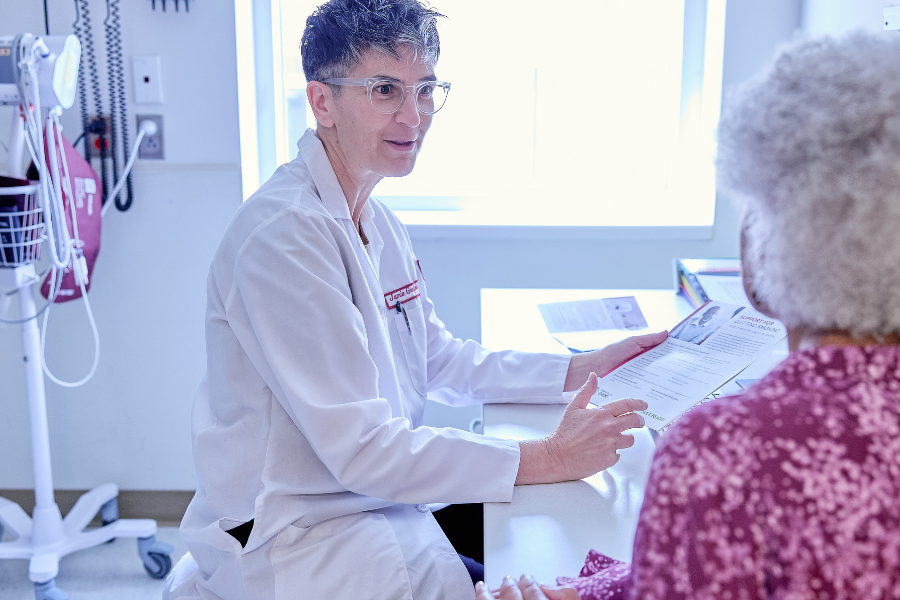Julie Pauly is exhausted—in a good way. As the owner of The Able Baker in Maplewood, NJ, she and her staff spent the past few months churning out hundreds of pies, thousands of cookies, and "fabulous chocolate walnut tarts for Christmas," she said. Clearly, Pauly is due for a well-deserved rest.
You'd never know it from her boundless energy, but last year, Pauly could barely walk half a block without needing to catch her breath. "One flight of stairs was the most I could do," she remembered. There were other trouble signs too, such as edema (swelling from retained fluids) that caused her to gain 10 pounds in three days: "Not a single pair of shoes fit!"
Since 2006, Pauly had been living in the shadow of hypertrophic cardiomyopathy (HCM), a condition in which part of the heart muscle swells and stiffens. She’d had a defibrillator implanted in her heart and took medication, but these measures couldn’t keep her condition from progressing to diastolic heart failure, in which the lower left chamber (ventricle) of her heart was no longer able to properly fill with blood. By last summer, Pauly's HCM had become "obstructive," blocking blood flow from the heart, and she needed help fast.
Common Threat
Pauly is not alone. About one in 500 people suffers from HCM, a condition that often has genetic links. After Pauly's diagnosis, her mother also received a diagnosis of HCM, and they suspect the condition may have affected others in their family.
Usually, HCM makes the news when a young athlete, previously unknown to have heart trouble, suddenly dies from it. But the condition can lurk undetected through middle age and beyond, and its symptoms— such as fatigue, heart palpitations, breathlessness, and chest pain—can mimic other illnesses. Scientists don't yet understand why HCM occurs, but can point to about 20 genetic markers for it.
"A large majority of patients with HCM are treated medically," said Daniel Dries, MD, MPH, Director of the Familial Cardiomyopathy Program at Temple University Hospital (TUH), which offers patients medication, nutritional guidance, risk assessment, and genetic testing for family members. "With appropriate treatment," Dr. Dries observes, "these people live normal lives."
A New Approach
A fraction of those with HCM, like Pauly, need surgery. In a procedure called a septal myectomy, the surgeon cuts away part of the enlarged septum (the dividing wall between the heart's right and left sides), removing the obstruction and enabling blood to more easily leave the heart. Some patients, Pauly included, also have surgery on the heart's mitral valve to keep it from "leaking" blood.
"Referral to our program does not necessarily mean surgery," explained T. Sloane Guy, MD, MBA, Chief of Cardiovascular Surgery and Robotic Surgery at TUH. The program "offers a comprehensive, multidisciplinary look at your condition from soup to nuts," with an emphasis on "getting the best possible type of care," he said.
For those who do need surgery, however, Dr. Guy points out that Temple is one of only a few places in the country where septal myectomies can be performed robotically. This method is minimally invasive and gives the surgeon a better view of the problem. According to Dr. Guy, "outcomes of patients have been extraordinary."
Pauly says that was a major factor in her decision to come to Temple. "Dr. Guy was very positive about the results he’d had with robotic septal myectomy," she noted. For a busy baker staring down the holiday season, "the robotic approach held even greater appeal … I could be back to work sooner."
Back in Business
Those expectations were more than met. Staff at TUH "really hustled" to prepare Pauly for her July 8, 2014 surgery. The following morning, she recalled, "they had me up and walking." Four days later, Pauly went home, needing only acetaminophen for pain relief. In a few weeks, she was walking three miles a day; in a month, she was back at the bakery part-time.
"People couldn't believe I'd had major heart surgery," said Pauly. She quickly resumed her hectic work and family life, feeling even healthier than before: "My daughter said, 'Wow, Mom with a good heart is noticeably better!'"
Though Pauly still has HCM—the surgery eliminated the obstruction, but her heart muscle is "still on the stiff side"—she is very pleased with the quality of life she regained. And she is full of praise for the care she received at TUH. Pauly calls the physicians, nurses, and physical therapists who worked with her "receptive, knowledgeable, good communicators and listeners." If the obstruction ever returned, she affirms that she would come back to Temple.
For now, Pauly is enjoying a break from baking after the holiday rush. But not for long. Because this able baker knows that February is coming, and with it, a demand for sweet treats shaped like perfect hearts.

